How to Manage Omnichannel Touchpoints in 2025
The strategic management of omnichannel touchpoints involves ensuring consistency, personalization and efficiency, allowing customers to transition effortlessly between channels.

The strategic management of omnichannel touchpoints involves ensuring consistency, personalization and efficiency, allowing customers to transition effortlessly between channels.

Modern customers expect a seamless experience across multiple channels when interacting with a brand. Are you utilizing omnichannel touchpoints to engage and retain customers? Brands with omnichannel strategies retain on average 89% of their customers.
Due to the rise of e-commerce and the widespread use of smartphones, customers have more options than ever when it comes to shopping. They can browse online, visit physical stores, and interact with brands through social media, among other channels. It has given rise to the concept of omnichannel customer experiences, where companies aim to create a unified and consistent customer experience across all touchpoints.
Omnichannel touch points are essential for businesses that want to stay competitive in the markets. Let us explore what these touchpoints are and how they can benefit your business.
Omnichannel touchpoints can be defined as the various interaction points where customers engage with a brand across multiple channels and platforms throughout their customer journey. These touchpoints seamlessly integrate physical and digital experiences, creating a cohesive brand experience regardless of how customers choose to interact.
The omnichannel approach connects all customer interaction channels through integrated systems and databases. When customers start their journey on a mobile app, continue on a desktop website and complete it in a physical store, the system maintains continuity by sharing interaction history across all platforms. The integration enables businesses to provide personalized experiences and maintain context across every touchpoint, effectively eliminating the traditional silos between different channels.
Key principles:
Below are the key benefits of implementing omnichannel touchpoints in your business strategy, illustrating how a holistic approach can transform your customer relationships.
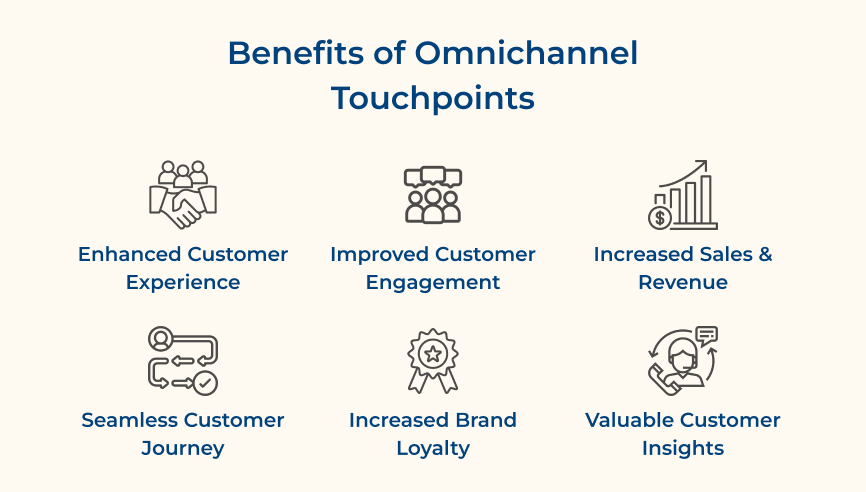
Businesses can offer customers a consistent and cohesive experience across all channels by providing multiple touchpoints. It means the customers can start an interaction on one channel and seamlessly transition to another without any disruption. Such a level of convenience is bound to enhance customer satisfaction and loyalty.
Omnichannel touchpoints allow businesses to engage with customers on a more personal level. Companies can understand customer preferences and behaviors by gathering data from various touchpoints, allowing them to deliver personalized marketing messages. It leads to higher customer engagement and better conversion rates.
Businesses can drive more sales and revenue by leveraging multiple touchpoints. Omnichannel customers tend to spend more than those who only interact with a single channel. An example here can be a customer who receives a promotional email and then visits a physical store to make a purchase. They are likely to spend more than a customer who only interacts with one channel.
Omnichannel touchpoints enable a seamless customer journey from the initial awareness stage to the final purchase. Customers can research products online, read reviews and visit a store to see or try out the product. It allows them to even make a purchase online and receive after-sales support through different touchpoints. 74% of CX professionals say creating a seamless customer journey across is “important” or “very important.”
When customers have a positive and consistent experience across multiple touchpoints, they are more likely to develop a sense of loyalty towards the brand. Loyalty leads to repeat purchases and advocacy, with customers recommending the brand to others. It leads to attracting new customers and expanding the customer base.
Each touchpoint provides valuable insights into customer preferences and behaviors. Analyzing the data allows businesses to make informed decisions, optimize their marketing strategies and improve their overall customer experience. These insights can also be used to personalize messaging, offers, and recommendations, further enhancing the customer experience.
Following are some effective ways to streamline your omnichannel approach and ensure that every interaction elevates your brand.
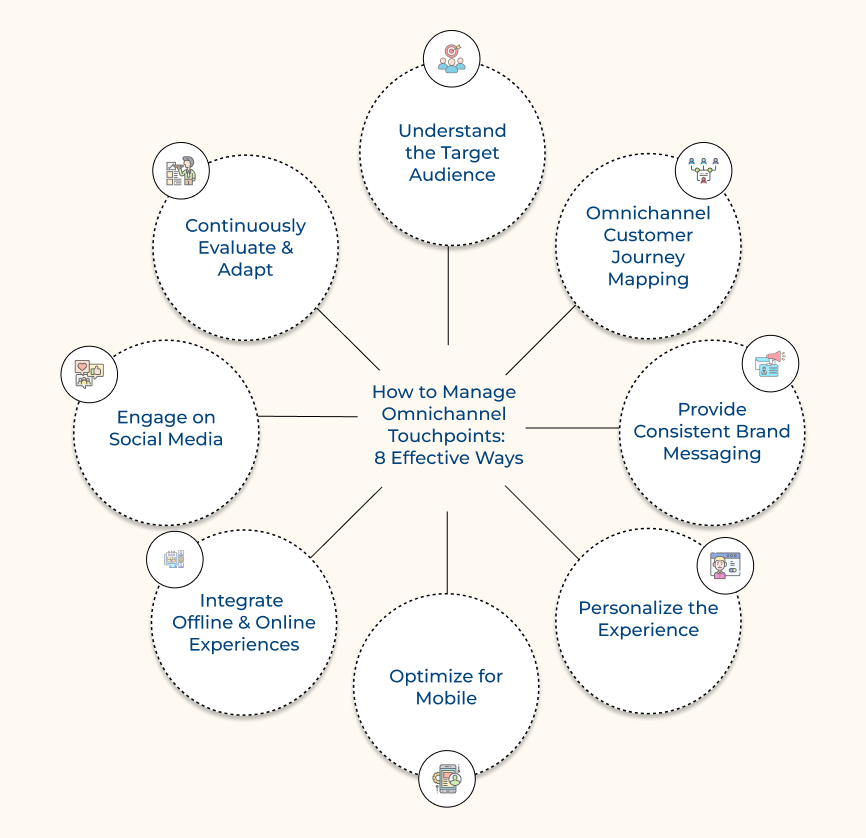
Businesses can tailor their messaging and content across various channels by thoroughly comprehending who their audience is. It’s important to recognize that each touchpoint is an opportunity to engage and connect with the audience. Understanding the preferences and behavior of the audience helps the brands to optimize the interactions for maximum impact.
Let’s say a business is targeting millennials. Then they may focus on social media platforms like Instagram or Snapchat. If the audience consists of older adults, then they might prioritize other digital channels such as email or direct mail.
Pro tips:
Mapping the customer journey gives businesses a deep understanding of how their customers interact with various touch points across different communication channels. It allows them to optimize their marketing strategies, improve customer satisfaction and drive more conversions. Omnichannel customer engagement strategies retain on average 89% of their customers.
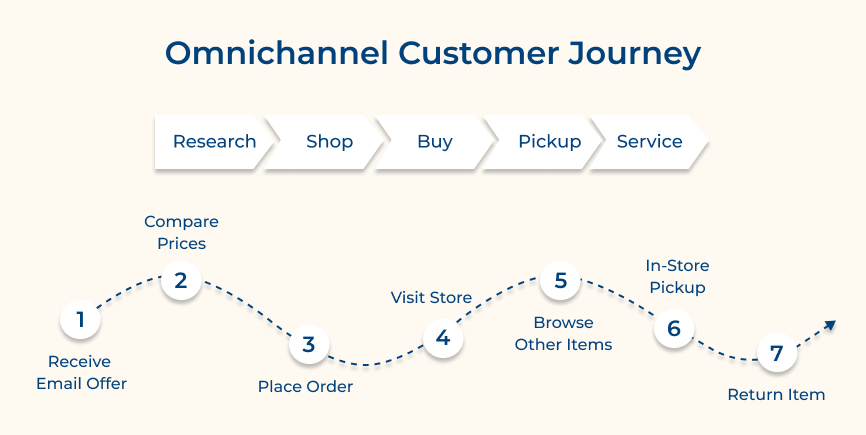
Consider the example of a clothing retailer who by mapping the customer journey can identify that customers often start their journey by browsing the website, then move to social media for inspiration and purchase the mobile app. Armed with the information, the retailer can tailor their marketing efforts and create a seamless experience across the touchpoints to boost their sales.
Pro tips:
When it comes to managing omnichannel touchpoints, providing a consistent message is crucial. It means ensuring the brand’s message remains the same across all channels, whether it’s social media, email marketing, or in-store experiences. Brand consistency can increase revenue by 10-20%.

Think of a clothing retailer that promotes sustainability. They should emphasize the message consistently across all touchpoints. Their website, social media posts – everything about the brand should highlight their eco-friendly practices and commitment to the environment. It enables them to establish a consistent brand identity, attracting like-minded customers and promoting trust in their sustainability efforts.
Pro tips:
Personalizing the experience has become a crucial aspect of managing omnichannel touchpoints. Companies can create a more engaging and relevant experience by tailoring interactions to each customer. Personalization enables businesses to build stronger connections with customers, increase customer loyalty and drive sales.
Let’s take the example of an online entrepreneur who can use personalization to show product recommendations based on their customer’s browsing history. It will lead to a more personalized and enjoyable shopping experience. Personalization is always essential in the competitive market to provide a seamless and targeted omnichannel experience.
Pro tips:
Optimizing for mobile is a crucial aspect of managing omnichannel touchpoints. The importance of optimizing for mobile cannot be understated. A mobile-friendly user experience not only improves customer satisfaction but also boosts conversions and enhances brand reputation. The majority of online browsing and purchases happen on mobile devices now, making it vital for businesses to prioritize mobile optimization.
Consider a retailer that can utilize mobile responsive design, enabling customers to easily browse and purchase products on their smartphones, tablets, or even smartwatches. The holistic approach to managing touchpoints ensures a seamless customer journey and maximizes the potential of mobile marketing.
Pro tips:
Integrating offline and online experiences is crucial in managing omnichannel touch points effectively. The approach ensures customers have a seamless experience across various channels, bringing together both the physical and digital aspects of a brand. Integrating offline channels and online channels allows businesses to provide customers with a unified message, building stronger brand loyalty.
A clothing retailer can integrate offline and online experiences by offering options such as click-and-collect. Customers can purchase items online and collect them in-store. It allows them to enjoy the convenience of online shopping while still having the opportunity to physically try on and feel the products.
Pro tips:
The importance of engaging on social media cannot be emphasized enough. It allows businesses to build relationships with their customers, increase brand loyalty and gather valuable insights. The approach provides an opportunity to showcase exceptional customer service and address concerns promptly, enhancing overall customer satisfaction.
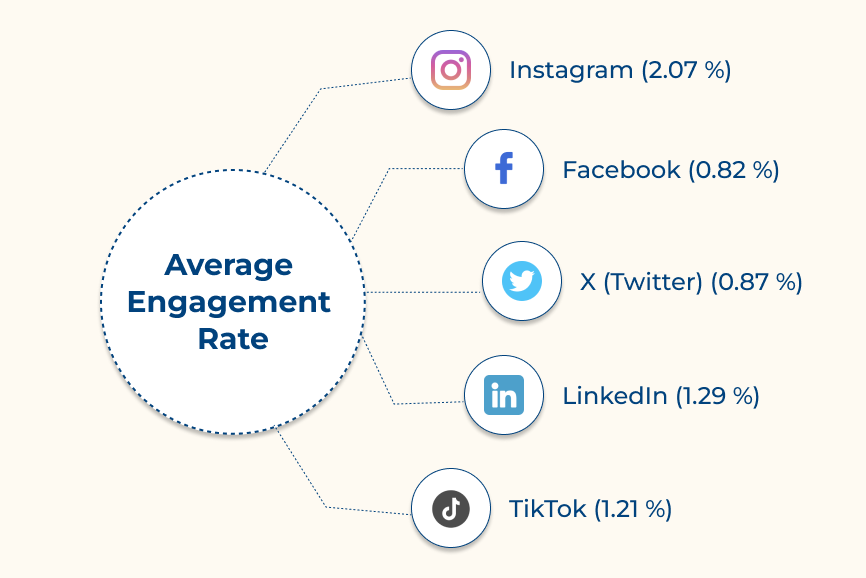
Let’s consider a clothing brand as an example. They can engage with their followers by hosting live Q&A sessions, sharing behind-the-scenes content, and responding to fashion-related queries. Actively managing omni-channel touch points through social media engagement, allows businesses to strengthen their online presence and establish lasting connections with the target audience.
Pro tips:
Continuously evaluating and adapting your omnichannel touch points allows businesses to stay agile in an ever-changing landscape. It ensures their marketing efforts are aligned with customer preferences and behaviors. Continuous evaluation and adaptation are essential for businesses to thrive in the competitive world of omnichannel.
A retail brand may find that its social media presence is driving significant traffic, while its email campaigns are not yielding the desired results. They can adapt their strategies and allocate resources where they will have the most impact by evaluating the data. It ultimately results in improving engagement, conversions and customer satisfaction.
Pro tips:
Let’s go through some inspiring examples of brands that have successfully embraced omnichannel touchpoints, demonstrating how they connect with consumers across multiple platforms.
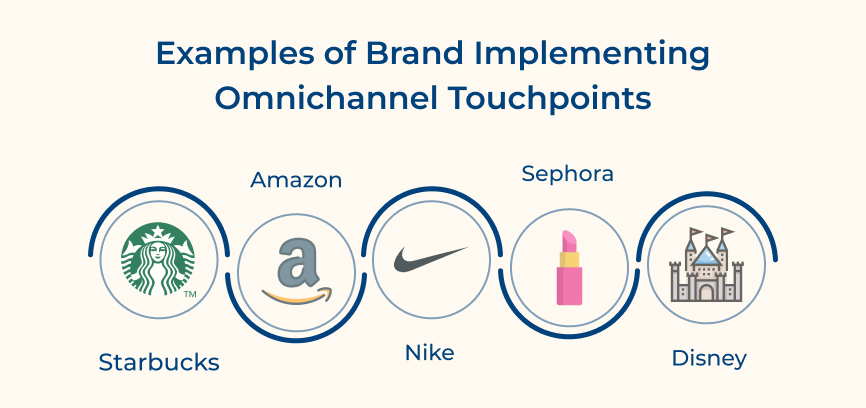
1. Starbucks
Starbucks is a global coffeehouse chain that has successfully implemented an omnichannel touchpoint approach to enhance its brand experience. Owing to a seamless integration of physical stores, online platforms and mobile applications, Starbucks has made it easier for customers to connect with their brand across various channels.
One of the key omnichannel touchpoints that Starbucks has implemented is mobile ordering and payment through their mobile app. It allows customers to order their favorite drinks in advance, skip the line and simply pick up their orders at their nearest Starbucks location. They have also integrated loyalty programs into their app, rewarding customers with points and personalized offers to enhance customer retention.
The outcome of Starbuck’s omnichannel strategy has been increased customer satisfaction and convenience. Offering multiple touchpoints in the omnichannel customer journey has allowed them to create a cohesive brand experience for customers. Starbucks serves one of the primary omnichannel touchpoint examples of how a brand can create a seamless and engaging customer journey.
2. Nike
Nike is a global athletic brand that has successfully implemented omnichannel touchpoints for customer experience. Nike understands the importance of being present across various channels to cater to its diverse customer base. From physical stores to e-commerce platforms and social media, Nike has strategically integrated its brand message and offerings.
Nike’s omnichannel strategy involves seamless integration of its online and offline channels. They have a robust website and mobile app that provide customers with a convenient shopping experience. Nike has invested in creating interactive and immersive retail spaces, where customers can engage with the brand.
The outcome of Nike’s omnichannel customer experience is increased brand engagement and customer loyalty. Customers can seamlessly transition between different channels, making their shopping experience more personalized and convenient. Nike’s approach has allowed them to differentiate themselves in the market and maintain a strong brand presence.
3. Sephora
Sephora is one of the best omnichannel touchpoint examples of a brand that has successfully enhanced its customer experience. Being committed to innovation and personalized interactions, Sephora has become a leader in the beauty industry.
Sephora has created multiple touchpoints to engage with customers at various stages of their purchasing journey. Their app allows users to purchase products, watch tutorials and receive personalized recommendations. Sephora’s website provides detailed product information and offers an easy-to-navigate online shopping experience.
The outcome of Sephora’s emphasis on omnichannel touchpoints is evident in its loyal customer base and increased sales. Sephora has created a cohesively immersive shopping experience by seamlessly integrating its online and offline channels. It has helped to promote customer satisfaction and drive brand loyalty.
4. Disney
Disney has successfully implemented omnichannel touchpoints for customer experience to increase brand loyalty. Owing to its seamless integration of various channels, Disney has created a unified and immersive experience for its audience.
Disney has strategically utilized omnichannel touchpoints to reach its customers wherever they are. An example is that the customers can plan their visit to Disney’s theme parks through their website, book tickets via mobile apps, customize their experience with MagicBands and then share their memories on social media.
The outcome of Disney’s omnichannel touchpoint approach has been remarkable. It has managed to strengthen its customer relationships and brand loyalty. The brand’s ability to seamlessly transition customers from one channel to another has resulted in increased revenue and enhanced customer satisfaction.
5. Amazon
When it comes to omnichannel marketing, Amazon is undoubtedly a frontrunner. The global e-commerce giant has strategically implemented omnichannel customer experience to create a seamless customer journey across multiple channels.
Amazon has integrated digital assistants like Alexa, allowing customers to shop and make purchases effortlessly through voice commands. They have even gone a step further with their acquisition of Whole Foods, bridging the gap between online and in-store grocery shopping.
The outcome of Amazon’s omnichannel touchpoint approach has been remarkable. Customers can effortlessly switch between channels, enjoying a consistent and personalized experience. Amazon’s success exemplifies the power of building a robust omnichannel presence to engage customers and drive sales.
Explore the best practices businesses can use for optimizing their omnichannel strategy to elevate the customer experience.
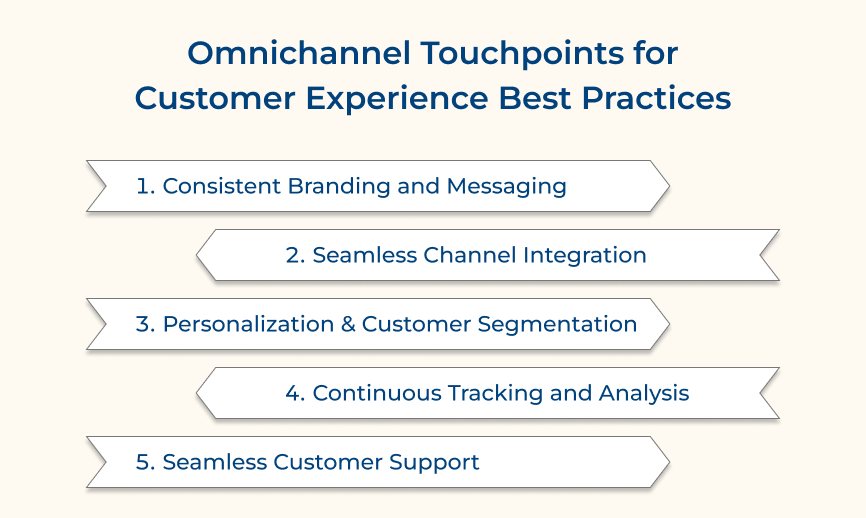
One of the key principles of omnichannel marketing is maintaining a consistent brand image and message across all touchpoints. Whether it’s a website, social media page, email campaign, or physical store, customers should instantly recognize and associate the content with the brand. It includes using consistent logo placement, typography, color schemes, and tone of voice. Businesses can reinforce their brand identity and create a coherent experience for customers by ensuring consistency.
Providing a seamless omnichannel experience might not be possible without integrating all channels and touchpoints effectively. It means that when customers switch between different platforms or devices, they should encounter a smooth transition. There should be no inconsistencies and disruptions. Take the example of a customer who adds a product to their online shopping cart. They should be able to continue the transaction on their mobile device without any issues.
Omnichannel marketing allows businesses to analyze customer data from multiple channels, enabling highly targeted and personalized campaigns. Leveraging customer insights allows companies to segment their audience based on demographics, preferences, behavior, or purchase history. It enables them to deliver tailored content and offers that align with individual customer interests. Personalization not only improves engagement but also cultivates loyalty and long-term customer relationships.
Businesses must continuously analyze the performance of each channel and touchpoint to optimize omnichannel touchpoints. Companies can gather valuable data on customer interactions, engagement rates, conversion rates, and other key metrics by utilizing analytics tools. The data-driven approach allows businesses to identify trends, detect areas of improvement and make informed decisions to enhance their marketing strategies.
An often overlooked aspect of omnichannel marketing is providing seamless customer support across all touchpoints. Customers should have access to consistent assistance and solutions, regardless of whether they interact through email, social media, live chat, or phone calls. Integration between customer support systems and various communication channels ensures that customers can easily reach out to receive a timely response.
Reaching customers at every step of their journey with omnichannel touchpoints is crucial for businesses. Incorporating various channels such as social media, websites, mobile apps, and offline experiences allows companies can create omnichannel touchpoints for customer experience.
The approach allows brands to engage with customers across multiple platforms, providing consistent messaging and building stronger relationships. Omnichannel touch points enable businesses to meet customers wherever they are in their journey. Leveraging the touchpoints effectively allows companies to increase customer satisfaction, loyalty and drive business growth. It’s time for businesses to embrace the power of omnichannel marketing and elevate their customer experience to new heights.
Effective management of omnichannel touchpoints is crucial for businesses to provide a seamless and personalized customer experience across multiple channels. Key strategies include integrating systems to ensure consistent data, leveraging customer data to personalize interactions, implementing automation for efficient communication and regularly optimizing touchpoints based on customer feedback.
Omnichannel touchpoints refer to various channels through which a customer can interact with a brand, ensuring a seamless and integrated experience. The touchpoints can include physical stores, websites, mobile apps, social media platforms, email, live chat, call centers, and even voice assistants. Leveraging multiple channels allows businesses to provide consistent messaging and personalized interactions, enhancing customer satisfaction.
Customer data plays a crucial role in optimizing omnichannel touchpoints. Collecting and analyzing customer data from various channels gives businesses insights into customer preferences, behaviors, and interactions. The data allows companies to personalize and tailor their marketing efforts across different touchpoints, ensuring a seamless experience for customers.
Consistency is key when it comes to creating a seamless omnichannel experience for customers. Companies should have a clear brand identity and messaging strategy. They should also implement centralized data management systems, use marketing automation tools and provide training to employees to ensure they adhere to the brand guidelines. Regular monitoring and analysis of customer feedback can also help identify any discrepancies or areas that need improvement.

Market better, sell faster and support smarter with Veemo’s Conversation Customer Engagement suite of products.
Unify all your customer data in one platform to deliver contextual responses. Get a 360 degree view of the customer lifecycle without switching tools.
Connect with the tools you love to reduce manual activities and sync your business workflows for a seamless experience.
 https://veemo.io/wp-content/uploads/2024/12/customer-service-response-time.png
1256
2400
indrasish5342@gmail.com
https://veemo.io/wp-content/uploads/2024/11/veemo.svg
indrasish5342@gmail.com2025-10-17 10:51:142025-12-15 05:49:239 Effective Tips to Reduce Customer Service Response Time
https://veemo.io/wp-content/uploads/2024/12/customer-service-response-time.png
1256
2400
indrasish5342@gmail.com
https://veemo.io/wp-content/uploads/2024/11/veemo.svg
indrasish5342@gmail.com2025-10-17 10:51:142025-12-15 05:49:239 Effective Tips to Reduce Customer Service Response Time https://veemo.io/wp-content/uploads/2024/10/How-to-Create-Knowledge-Base.png
1257
2400
Vikas Sachan
https://veemo.io/wp-content/uploads/2024/11/veemo.svg
Vikas Sachan2024-10-21 12:24:342025-12-15 05:58:17How to Create a Knowledge Base in 9 Easy Steps: The Ultimate Guide
https://veemo.io/wp-content/uploads/2024/10/How-to-Create-Knowledge-Base.png
1257
2400
Vikas Sachan
https://veemo.io/wp-content/uploads/2024/11/veemo.svg
Vikas Sachan2024-10-21 12:24:342025-12-15 05:58:17How to Create a Knowledge Base in 9 Easy Steps: The Ultimate Guide https://veemo.io/wp-content/uploads/2024/02/Live-Chat-for-Sales.png
628
1200
Vikas Sachan
https://veemo.io/wp-content/uploads/2024/11/veemo.svg
Vikas Sachan2024-10-21 11:31:222025-12-15 05:58:19How to Use Live Chat for Sales? 7 Proven Ways to Grow Revenue
https://veemo.io/wp-content/uploads/2024/02/Live-Chat-for-Sales.png
628
1200
Vikas Sachan
https://veemo.io/wp-content/uploads/2024/11/veemo.svg
Vikas Sachan2024-10-21 11:31:222025-12-15 05:58:19How to Use Live Chat for Sales? 7 Proven Ways to Grow RevenueGrow Customer Relationships and stronger team collaboration with our range of products across the Conversational Engagement Suite.

 The Definitive Guide to Automated Ticketing System
Scroll to top
The Definitive Guide to Automated Ticketing System
Scroll to top